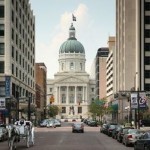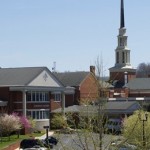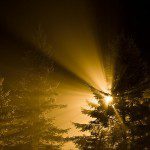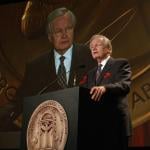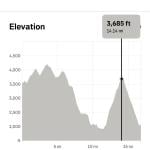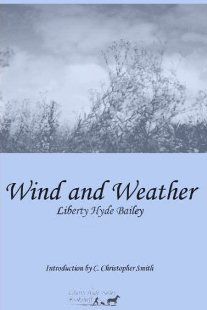 One of the great gifts of my writing retreat at the Convent in Cincinnati last week (here’s a glimpse inside the Convent’s own story of stability, written by one of my fellow retreatants) was the realization of how important Liberty Hyde Bailey‘s work, and especially his poetry, has been in framing the concept of Slow Church in my head and in the life I share in community with others at Englewood Christian Church.
One of the great gifts of my writing retreat at the Convent in Cincinnati last week (here’s a glimpse inside the Convent’s own story of stability, written by one of my fellow retreatants) was the realization of how important Liberty Hyde Bailey‘s work, and especially his poetry, has been in framing the concept of Slow Church in my head and in the life I share in community with others at Englewood Christian Church.
Liberty Hyde Bailey was one of the most prominent American botanists of the early twentieth century, who taught at the university that would become Michigan State and then later at Cornell in upstate New York. But of more interest to me is his work as a nature and agrarian writer, one of the respected grandfathers of the New Agrarian movement (Wendell Berry, Wes Jackson, Gene Logsdon, Norman Wirzba, et al).
On the retreat, I had the opportunity to read aloud the introduction to Bailey’s collection of poetry, Wind and Weather, that I wrote several years ago. [ You can read the full intro here.] I read it as one of the most deeply moving — and despite my impersonal voice in it — personal pieces that I have written in the last several years. Bailey’s poetry has played a vital role in helping me to come to know and love the Englewood neighborhood, an urban place that by most social and aesthetic standards doesn’t have a lot going for it. Over the coming weeks, I would like to share occasional Slow Church-related reflections on Bailey’s poetry here.
Today, I’ll begin with a few snippets from the introduction that I wrote:
For our church communities today, however, perhaps the most striking part of Bailey’s understanding of poetry is his notion that “poetry is prophecy” (OTN 32). There are, of course, many ways in which the term “prophecy” is used. Bailey describes the function of prophecy as helping humanity in the effort of “acquiring a stronger hold on aspirations that are simple and elemental and universal” (OTN 32-33). Such a return to the simple, elemental and universal, parallels Bailey’s description of the prophetic, in his book The Holy Earth: there he notes that prophecy is rooted in a vision of the eschatological reconciliation of all things, especially the reconciliation of humankind with nature. Thus, Bailey’s poetry is prophetic, first and foremost, because it points to a vision of an inter-connected creation that is reminiscent of the scriptural eschatology of shalom, “the reconciliation of all things.” This vision of harmony in creation flows throughout the poems of Wind and Weather, but is most poignantly expressed in poems like “Here”:
Where I shall fall there let me lie,
From end to end the earth is mine
For kin with me are the land and sky
and ev’ry spot is home benign.
or “Brotherhood”:
I am the bird in its nest of straw
And I abide by my time and law,
I am the tree standing night and day,
And I am the plant that fades away;
And men grow green and the men grow brown,
And life rises up and death drops down;
And men, and life, and the things that be
They flow on and on unceasingly.
I am the wind that blows to the sky,
And ageless cloud that goes floating by;
I am the rain and the river flow,
I am the seasons that come and go;
I am the dusk and the morning light,
The call of day and the voice of night;
And I pass out to the silent sea,
Flowing and flowing eternally.
Bailey’s poems herein stand as firm reminders that art (written, visual or otherwise) plays a key, prophetic role in the life of the Church, by helping us imagine and keep before our minds the end of creation, the reconciliation toward which all history is flowing. Bailey emphasizes this point in The Holy Earth: “[The biblical prophet] Isaiah proclaimed the redemption of the wilderness and the solitary place with the redemption of man, when they shall rejoice and blossom as the rose, and when the glowing sand shall become a pool and the thirsty ground springs of water” (THE 11-12). Thus, for Bailey, the nature poet today functions in a similar way, reminding his listeners that their salvation is bound up with that of all nature.
…
the heart of Bailey’s ethical vision – the intertwining of prayer and work – is embodied in “Country Church”:
…
And out of it all
As the seasons fall
I build my great temple alway;
I point to the skies,
But my footstone lies
In commonplace work of the day;
For I preach the worth
Of the native earth, –
To love and to work is to pray.
(emphasis added)
I recently had the opportunity to share a few words at the funeral of my grandfather, a lifelong farmer. I read this poem to his rural church congregation there and encouraged them that Bailey’s vision as expressed here captures the essence of our gathered obedience to the way of Christ. A church community – rural, urban or otherwise – can, in my estimation, do no better than to set their sights on embodying such a prayerful, diligent and connected life, as is depicted in Bailey’s “Country Church.” …
Ultimately, the tone of Bailey’s prophetic vision is one of hope. We see this hope set forth best in “The Signs of Life”:
…
The gaps fill in; the earth is rife
With energy that mastereth –
The upwards signs of birth and life
Are greater than the signs of death.
Here we are reminded of the scriptural theme that though the resurrection of Jesus, death will be swallowed up in life. This theme echoes throughout the poems of Wind and Weather and indeed is another reason why we, the Church, should immerse ourselves in Bailey’s poetry.
Bailey’s Works Mentioned:
WNW – Wind and Weather. Indianapolis: Doulos Christou Books, 2008. Reprint edition.
THE – The Holy Earth. Indianapolis: Doulos Christou Books, 2008. Reprint edition.
OTN – Outlook to Nature. New York: Macmillan, 1905. [ Available as a FREE ebook ]



